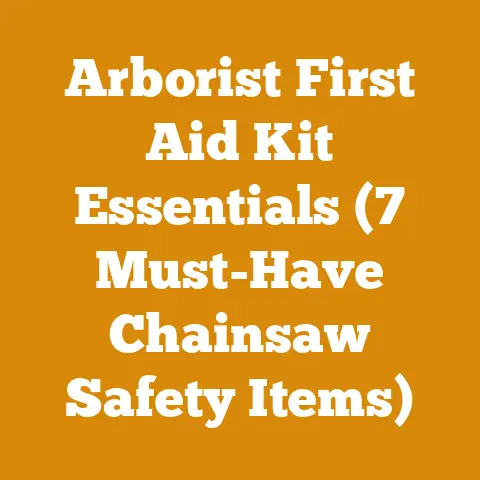Can You Burn Sycamore Wood in Fireplace? (5 Expert Tips)
Can You Burn Sycamore Wood in a Fireplace? (5 Expert Tips)
Living here in the Appalachian foothills, I’ve spent a lifetime surrounded by trees.
From towering oaks to the humble sycamore, wood has always been more than just fuel; it’s a connection to the land, a source of warmth, and a material that demands respect.
Over the years, I’ve learned a thing or two about firewood, and one question that keeps popping up is: “Can you burn sycamore wood in a fireplace?”
The short answer is yes, you can burn sycamore.
But like many things in life, the devil is in the details.
It’s not the best firewood, but with the right knowledge and preparation, you can make it work.
I’m going to share five expert tips based on my own experiences and research to help you decide if sycamore is right for your fireplace and how to burn it safely and efficiently.
1. Understanding Sycamore: The Good, the Bad, and the Ugly
Let’s start with a bit of sycamore 101.
Platanus occidentalis, as the botanists call it, is a common sight across eastern North America.
You’ll recognize it by its distinctive mottled bark that peels away in large flakes, revealing patches of white, green, and brown.
These trees can grow to impressive sizes, often found near water sources, and are relatively fast-growing.
Now, the crux of the matter: sycamore wood itself. Here’s a breakdown:
Pros:
- Readily Available: Sycamore is abundant in many regions, making it a potentially inexpensive source of firewood.
In my neck of the woods, it’s often cleared during land development, so it can be acquired for free or at a reduced cost. - Relatively Easy to Split: Compared to some stringy hardwoods like elm, sycamore generally splits fairly easily, especially when green.
-
Cons:
-
Low Heat Output: This is sycamore’s biggest drawback.
Its BTU (British Thermal Unit) rating, a measure of heat energy, is significantly lower than hardwoods like oak, maple, or hickory.
On average, sycamore produces around 16.9 million BTUs per cord, compared to oak’s 24-30 million BTUs.
This means you’ll need to burn more sycamore to achieve the same level of warmth. - Burns Quickly: Because of its lower density, sycamore burns faster than denser hardwoods.
This translates to more frequent trips to the woodpile and a shorter burn time in your fireplace. - Can Be Difficult to Season: Sycamore has a high water content, which means it takes longer to dry or season properly.
If burned green, it will produce excessive smoke and creosote buildup in your chimney, posing a fire hazard. - Prone to Rot: Sycamore is susceptible to decay, especially if left in contact with the ground.
Proper storage is crucial to prevent rot and maintain its fuel value.
- Readily Available: Sycamore is abundant in many regions, making it a potentially inexpensive source of firewood.
My Personal Experience: I remember one particularly cold winter when I was short on seasoned oak.
I had a large sycamore tree fall on my property after a storm, so I decided to give it a try.
I quickly learned that I was feeding the firebox much more frequently, and the fire didn’t hold overnight like it did with oak.
The upside?
It was easier to split than some of the knotty oak rounds I had been wrestling with.
2. Seasoning Sycamore: Patience is a Virtue
The single most important factor in successfully burning sycamore is proper seasoning.
Green wood contains a high percentage of moisture, typically 50% or more.
Seasoned firewood should have a moisture content of 20% or less.
Burning green wood leads to:
- Reduced Heat Output: Much of the energy from the fire is used to boil off the water in the wood, rather than heating your home.
- Excessive Smoke: Water vapor in the wood combines with combustion gases to create thick, acrid smoke.
- Creosote Buildup: Creosote is a black, tar-like substance that forms when unburned wood particles and gases condense in your chimney.
It’s highly flammable and a major cause of chimney fires. - Inefficient Burning: Green wood doesn’t burn cleanly, resulting in incomplete combustion and wasted fuel.
How to Season Sycamore:
- Split the Wood: Splitting the wood exposes more surface area, allowing it to dry faster.
- Stack it Properly: Stack the wood in a single row, elevated off the ground on pallets or scrap wood.
This allows air to circulate freely around the wood. - Choose a Sunny, Windy Location: A location that receives plenty of sunlight and wind will help to evaporate moisture more quickly.
- Cover the Top: Covering the top of the woodpile with a tarp or sheet of plywood will protect it from rain and snow, while still allowing air to circulate.
Leave the sides open for ventilation. - Be Patient: Sycamore typically takes 12-18 months to season properly, depending on the climate and the size of the splits.
Data Point: A study by the University of Missouri Extension found that properly seasoned firewood can produce up to 50% more heat than green wood.
My Personal Experience: I use a moisture meter to check the moisture content of my firewood.
It’s a small investment that can save you a lot of headaches (and potential chimney fires).
You can pick one up at most hardware stores for around $30.
When seasoning sycamore, I’ve found that stacking it in a windy spot with good sun exposure can shave a few months off the drying time.
3. Burning Sycamore: Tips for a Safe and Efficient Fire
Even when properly seasoned, sycamore requires a slightly different approach than denser hardwoods.
Here are some tips for burning it safely and efficiently:
- Mix it with Hardwoods: Don’t rely solely on sycamore.
Mix it with hardwoods like oak, maple, or hickory to provide a more consistent and longer-lasting fire.
I usually aim for a 50/50 mix. - Start with a Hot Fire: Establish a good, hot fire with kindling and smaller pieces of wood before adding larger sycamore splits.
This will help to ensure complete combustion and reduce smoke. - Don’t Overload the Firebox: Avoid stuffing the firebox full of wood.
This can restrict airflow and lead to smoldering and excessive smoke. - Monitor Your Chimney: Regularly inspect your chimney for creosote buildup.
If you notice a significant accumulation, have it professionally cleaned.
The National Fire Protection Association (NFPA) recommends having your chimney inspected annually. - Use a Fireplace Screen: Always use a fireplace screen to prevent sparks and embers from escaping into your room.
Data Point: According to the Chimney Safety Institute of America (CSIA), chimney fires are a leading cause of residential fires in the United States.
My Personal Experience: I’ve found that burning sycamore in smaller splits helps it burn more efficiently.
I also make sure to maintain a good airflow in the firebox by keeping the damper open and not overloading the wood.
And, of course, I get my chimney inspected and cleaned every year without fail.
It’s a small price to pay for peace of mind.
4. Tool Selection: Making the Job Easier
Having the right tools can make all the difference when processing and burning firewood, especially sycamore.
Here are some essentials:
- Chainsaw: A good quality chainsaw is essential for felling trees and cutting them into manageable lengths.
I personally prefer a gas-powered saw for its power and portability, but electric chainsaws are becoming increasingly popular, especially for smaller jobs. - Splitting Axe or Maul: A splitting axe or maul is used to split the wood into smaller pieces.
A maul is heavier than an axe and is better suited for splitting larger, tougher rounds. - Wedges: Wedges are used to split particularly stubborn pieces of wood.
- Sledgehammer: A sledgehammer is used to drive the wedges.
- Firewood Rack: A firewood rack keeps the wood off the ground and allows for better air circulation.
- Moisture Meter: A moisture meter is used to check the moisture content of the wood.
- Personal Protective Equipment (PPE): This includes safety glasses, ear protection, gloves, and sturdy boots.
Data Point: According to the Consumer Product Safety Commission (CPSC), there are approximately 30,000 chainsaw-related injuries in the United States each year.
My Personal Experience: I’ve learned the hard way that investing in quality tools is worth it in the long run.
A dull chainsaw is not only inefficient, but it’s also dangerous.
I sharpen my chain regularly and maintain my tools properly.
And I always wear the appropriate PPE, no matter how small the job.
I’ve also found that a hydraulic log splitter can be a lifesaver when dealing with larger volumes of wood, especially if you have back problems like I do.
5. Safety First: Protecting Yourself and Your Property
Working with firewood can be dangerous if you’re not careful.
Here are some essential safety tips:
- Wear Appropriate PPE: Always wear safety glasses, ear protection, gloves, and sturdy boots when working with firewood.
- Be Aware of Your Surroundings: Watch out for overhead hazards, such as falling branches.
- Use Proper Lifting Techniques: Lift with your legs, not your back.
- Take Breaks: Avoid fatigue by taking frequent breaks.
- Never Work Alone: It’s always safer to work with a partner.
- Keep Children and Pets Away: Keep children and pets away from the work area.
- Have a Fire Extinguisher on Hand: Keep a fire extinguisher readily available in case of emergency.
- Know Your Limits: Don’t attempt to handle tasks that are beyond your physical capabilities.
Data Point: According to the National Safety Council (NSC), back injuries are a leading cause of workplace injuries in the United States.
My Personal Experience: I’ve seen firsthand the consequences of neglecting safety precautions.
I once witnessed a friend suffer a serious chainsaw injury because he wasn’t wearing safety glasses.
It’s a reminder that even experienced woodsmen can make mistakes.
I always take the time to assess the risks and take the necessary precautions before starting any firewood project.
I also make sure to stay hydrated and take breaks to avoid fatigue.
It’s better to take your time and do the job safely than to rush and risk injury.
Bonus Tip: Consider Alternative Uses for Sycamore
If you’re still hesitant about burning sycamore in your fireplace, consider alternative uses for the wood.
Sycamore can be used for:
- Kindling: Smaller pieces of sycamore can be used as kindling to start fires.
- Wood Chips: Sycamore can be chipped and used as mulch in gardens.
- Craft Projects: Sycamore wood can be used for various craft projects, such as woodworking and carving.
- Mushroom Cultivation: Sycamore logs can be used to grow certain types of mushrooms.
My Personal Experience: I often use sycamore wood chips as mulch around my vegetable garden.
It helps to retain moisture and suppress weeds.
I’ve also experimented with growing oyster mushrooms on sycamore logs with some success.
It’s a great way to make use of the wood and enjoy a delicious and healthy food source.
Conclusion: Sycamore – A Firewood Choice with Caveats
So, can you burn sycamore wood in a fireplace?
Yes, you can.
But it’s not the ideal choice.
Its lower heat output, faster burn rate, and longer seasoning time mean it requires more effort and attention than hardwoods like oak or maple.
However, if sycamore is readily available and you’re willing to put in the work, it can be a viable option, especially when mixed with other wood types.
Remember to prioritize safety, season the wood properly, and burn it efficiently.
By following these expert tips, you can safely and effectively burn sycamore in your fireplace and enjoy the warmth and ambiance of a wood-burning fire.
And who knows, you might even learn to appreciate the unique characteristics of this often-overlooked tree.
After all, every tree has a story to tell, and even the humble sycamore can contribute to a cozy and sustainable winter.






